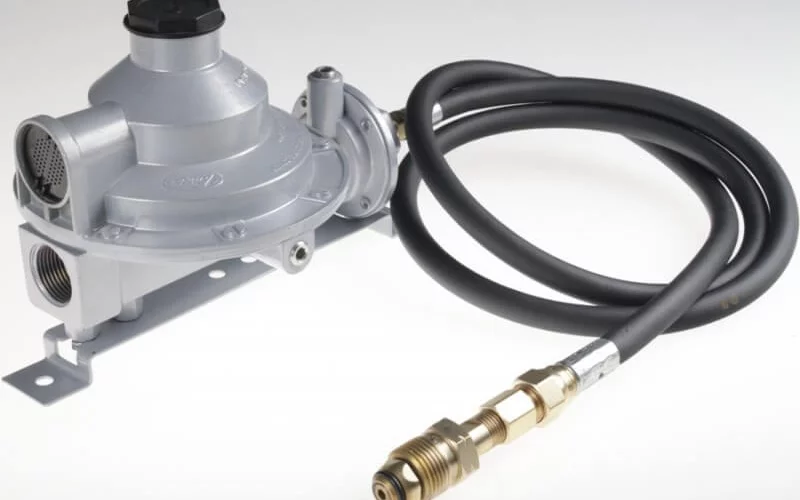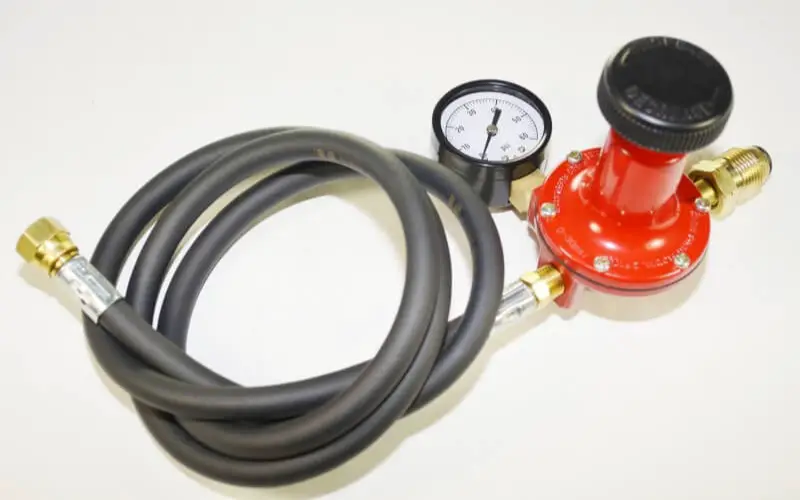A propane regulator controls the flow of gas from your propane tank to your burner. It reduces the high gas pressure from your tank and brings out gas of lower pressure in your burner.
There are two types of gas regulators, a high-pressure propane regulator, and a low-pressure propane regulator.
You may ask whether regulators do the same task. What are a high-pressure propane regulator and a low-pressure propane regulator?
Is there a difference between these two regulators? The answer is yes, there is a significant difference between a high and low-pressure regulator, and we discussed them below.
What Is a Low-Pressure Propane Regulator?

A low-pressure propane regulator is a regulator that reduces the gas pressure from your tank to 6 ounces per square inch (10.5 inches water column).
A low-pressure propane regulator is used on a propane tank that is close to its burner. This regulator is mostly used for a home propane tank.
What Is High-Pressure Propane Regulator

A high-pressure propane regulator is a regulator that reduces the gas pressure from your tank between 1 to 60 ounces per square inch.
A high propane regulator stands between the high pressure on the inlet (your tank) and the outlet (your burner) or some burners which may require a lower pressure to function.
When propane leaves its tank, it leaves with a high temperature that may lead to an explosion if not regulated; therefore, a propane regulator is important.
A red propane regulator that indicates high-pressure control can also be utilized when using gas equipment or burner with a high gas demand. The red propane regulator is frequently used with a second-stage regulator in a system that requires two regulators.
High-Pressure vs Low-Pressure Propane Regulator
What is the difference Between a High-Pressure and A Low-Pressure Propane Regulator?
The pressure of your gas can range from 100 to 200 psi; sometimes, it goes higher it all depends on the amount of heat your tank is subjected to by the sun.
An increase in temperature leads to increased pressure. If the psi becomes more than 200, it is too much. The increased pressure needs to be controlled before use.
Outdoor gas appliances such as highs heat cast iron burners need a high-pressure regulator because they need more gas than a low-pressure regulator can give. A high-pressure regulator controls an output between 1 to 60 psi.
A high-pressure regulator can receive supply pressure from a 3600-psi compressed gas cylinder without breaking it into pieces and still have a good pressure output. In contrast, a low-pressure propane regulator is rated for a pressure supply of 150 psi or lower.
Is A 20lb Propane Tank High or Low Pressure
At 70 degrees Fahrenheit, a 20lb tank (Liquefied propane cylinder) should be around 145 psi.
According to the pressure chart, the psi of a low-pressure propane burner is below 100, a normal psi ranges from 100 to 200, while an extremely high psi exceeds 200.
But generally, the standard propane pressure should be between 100 to 200 psi, but your 20lb propane tank can be high or low pressure depending on the temperature.
Do You Need a High or Low-Pressure Propane Regulator?
You can use a low-pressure propane regulator for your home or kitchen burner, which controls the pressure from the inlet and releases a low pressure at the outlet.
Your low-pressure regulator should be located close to your propane tank, which is also close to your home burner. Sometimes a low-pressure regulator is built into the gas appliance, but most times, you may need to purchase and install these regulators.
Some outdoor gas appliances need a high-pressure propane regulator because they need more amount of gas than a low-pressure regulator is allowed to give.
Some high-pressure regulators are preset; they have a fixed propane pressure like 15 psi or 20 psi.
Another type of high-pressure propane regulator is the adjustable high-pressure regulator; this regulator is available in a different range of pressure like 0 to 10 psi, 0 to 20 psi, and 0 to 30 psi; you can regulate your pressure within this ranges.
If you are thinking of purchasing a very high-pressure propane regulator for enough gas delivery, you may need to change your mind as there is no special benefit of having a propane pressure with more BTU per hour than you need.
Are Propane Grills Low or High Pressure?
Most propane grills for barbecues run on low pressure. This is because there is just sufficient heat provided at low pressure, and it is also safer than a high-pressure burner.
Using a high-pressure burner for grilling produces too much heat that may burn whatever you are cooking.
In addition, low-pressure propane grills are built cheaper than high-pressure propane grills that must be built to tolerate the amount of heat supplied.
What Is a High-Pressure Regulator for Propane?
High-pressure propane regulators regulate high pressure between your gas tank and your gas appliance outlet. High-pressure regulators are usually used for fryers and not grills.
To find the right regulator for your propane tank, you should be aware of your but requirements, and you can do this by checking the information sticker on your grill or burner.
If you have a total BTU of 60,000 or below, a normal hose and a basic regulator kit are okay, but a btu exceeding 60,000, a two-stage regulator is needed as it is the best option.
Do not use rubber hoses in an enclosed cabinet use a stainless-steel flex hose instead. Your propane regulator should be replaced every 10 to 15 years, but before that time, if your grill is having functional issues, you will need to purchase a new regulator.
What Temperature Is Too Cold for Propane?
As every substance has its melting point, boiling point, and freezing point, so does propane.
For people using a propane burner during winter, you get worried that your propane might freeze; for an above-ground propane tank, your propane might freeze inside or get damaged when the temperature drops down.
The freezing of propane gas happens at -44 degrees Fahrenheit, and while it is unusual for your propane to freeze, it is possible.
When an above-the-ground tank is left outside during a cold period, it shrinks, and your tank shrinking leads to a low propane pressure because propane contracts.
And a low propane pressure means propane won’t be able to reach your burners and any other appliance you have set up.
To avoid this, keep your propane tank full because, with more propane in your tank, there is more pressure, and do not let snow build up on your propane tank; clearing the snow will allow your propane tank to have direct access to sunlight which will keep the tank warmer.
You should also consider using an insulated frame shelter for your propane tank; applying heat tapes specifically designed for propane tanks help to keep the tank warmer. Burying your propane tank is another way of keeping it warm.
At What Temperature Does Propane Liquefy
Propane exists in two forms, liquid form, and vapor form. And just like steam and water, you begin to ask when propane gas becomes liquid and when propane liquid becomes a gas.
The liquefaction of propane depends on storage and temperature; propane gas can be liquid if the pressure of propane is increased without an increase in temperature; propane becomes liquid at a temperature below -44 degrees Fahrenheit.
LPG (liquid propane gas) can be turned into its gaseous state by vaporization. Liquid propane builds by absorbing heat from its steel walls, which gets heat from ambient air; this process turns liquid propane into gas.
Fun fact: do you know that liquid propane gas in your tank begins to boil? This vaporization process is how your liquid propane gas goes from liquid to vapor.
Conclusion: High-Pressure vs Low-Pressure Propane Regulator
There is a notable difference between a high-pressure propane regulator and a low-pressure propane regulator, after all. A high-pressure propane regulator allows more gas flow than a low-pressure propane regulator; high-pressure propane regulators are mostly used for fryers and not grills.
We have also seen that barbecue grills are mostly low pressure to provide just enough heat and safety at the same time. At a temperature below -44 degrees Fahrenheit, propane gas becomes liquid and can be poured out of its container like any regular liquid.
We have briefly explained what temperature is too cold for propane gas and the proper environment for your propane tank during winter, as freezing may lead to gas not getting into your burners and other gas appliances.
You May Also Like:
- Best Propane Fire Pit for Roasting Marshmallow
- How to Start a Fire in A Fire Pit? (With Explainer Video)
- Rick of Wood Dimensions – WHAT IS A RICK OF WOOD?
- Is it Safe To Roast Marshmallows On a Propane Fire Pit?
- How to Get Rid of a Tree Stump With Charcoal
We trust this article helped you understand High-Pressure vs Low-Pressure Propane Regulator and their key differences. You may also want to check out this article: Fire Pit Ring Insert Buyers Guide and Cost.
Thanks for taking the time to read our article, and we hope you find it helpful. Would you mind leaving a comment below if you have any suggestions?
Kindly reach out to people by sharing this post on social media.
If you liked this article, then please follow us on Facebook, Instagram, and Pinterest.
